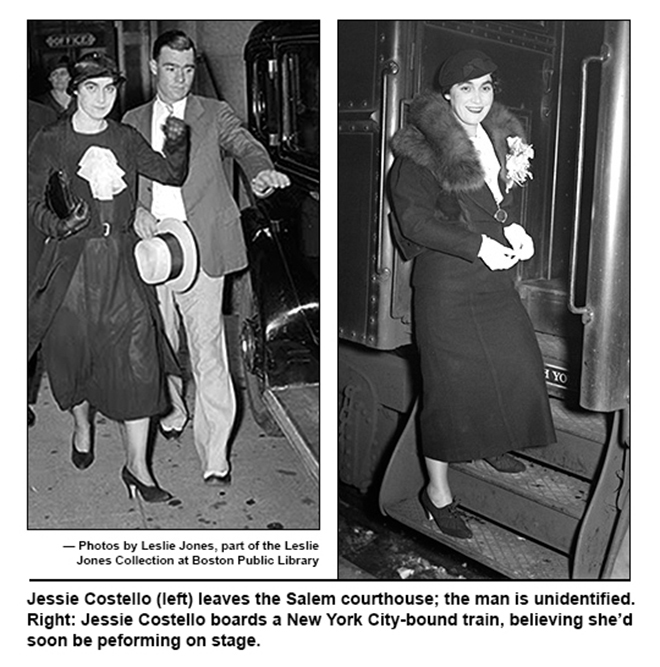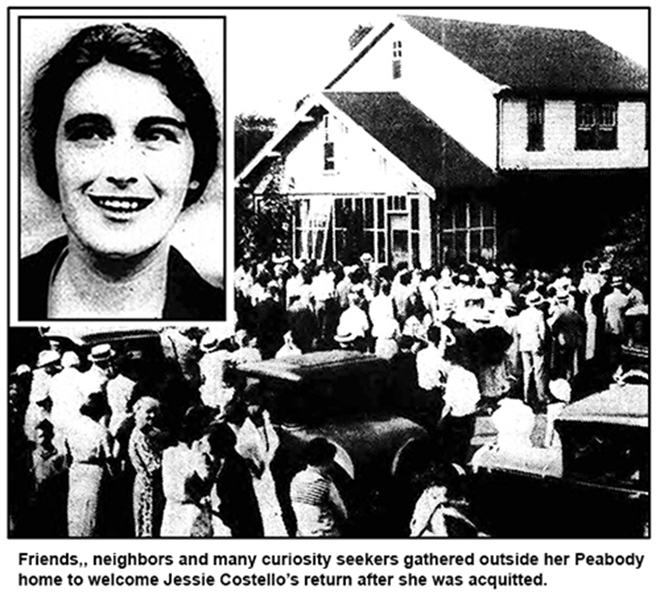| HOME • FAMILY • YESTERDAY • SOLVAY • STARSTRUCK • MIXED BAG |
 |
 |
Newspapers love juicy murders. This was especially true during the 1920s and '30s, and, in 1933, the press had a field day. There were several interesting cases, a few unbelievably bizarre — such as the Chicago murder of Rheta Gardner Wynekoop by her 66-year-old mother-in-law, Dr. Alice Lindsay Wynekoop, whose version of the crime changed daily. In time she would use every excuse except "The devil made me do it!" There was the case of Akron attorney Mark H. Shank who convinced a client to move his family to Arkansas to avoid questioning in a burglary. Shank followed, took the client and his family on a picnic — and poisoned them. Widely covered was the beating death of Allene Thorpe Lamson in Palo Alto, California, and the trial of her husband, David. This was a case that dragged on for many, many months. And then, there was "the smiling widow," Jessie Burnett Costello of Peabody, Massachusetts. IT'S A BIT of a stretch to portray Jessie Costello as a femme fatale, though that's precisely what some reporters did. By today's standards, she was at least 25 pounds too heavy and there was something decidedly masculine about the black eyebrows that arched her expressive eyes. Ah, but that ever-present smile. Few men, it seemed, could resist the woman. The trial of Jessie Costello was the year's media event, at least in the Northeast. The case remains one of the most baffling in Massachusetts history. Some folks came to believe no crime had been committed; luckily for Jessie Costello, this view was shared by a jury of 12 married men. They were so smitten with the woman usually identified by the press simply as Jessie, that they serenaded her, earning the nickname, "The Singing Jury." Indeed, it was a strange trial. Incredibly, when it began, it was considered a slam dunk for the prosecution. But after all the testimony and closing arguments, it took the jury just two hours to declare the defendant was not guilty. Jessie Costello was born in 1902, daughter of Andrew and Jessie Fyfe of Yonkers, New York. By her teens, Jessie's family was living in Massachusetts. She reviewed her life during her testimony: |
|
|
|
WHEN 38-YEAR-OLD William J. Costello Sr. died upstairs at home in February, 1933, it seemed initially that a heart attack was responsible. But an autopsy revealed the cause was cyanide of potassium poisoning. Authorities ruled out suicide or accidental death and decided Jessie Costello had poisoned her husband. (There is an unattributed remark in one news story that there was enough cyanide in Costello's body to kill a dozen men.) Mrs. Costello's supposed motive was her alleged affair with Edward J. McMahon, a former part-time local policeman. McMahon became known as the "kiss-and-tell cop" because of his testimony during the trial. At the same time, McMahon's sister, Catherine, agreed to be a defense witness and refuted much of her brother's testimony. Newspapers, despite their frequent sensationalism, were squeamish when it came to frank reporting on sexual matters. Likewise, in court, defendants in criminal and civil cases could have their reputations tarnished by admitting they had merely kissed someone who wasn't their spouse. It wasn't clear in newspaper stories what claims McMahon was making about his relationship with Mrs. Costello. Logistically, it would have been difficult for Jessie Costello and Edward McMahon to have the kind of full-blown, check-into-a-motel kind of affair so common today. Complicating matters, Jessie Costello had three small children and also cared for her father-in-law, John J. Costello, who lived with his son's family. For a while McMahon, his wife, and their two children also lived in the Costello house, at the invitation of William J. Costello. |
|
THE PROSECUTION'S case was built entirely on circumstantial evidence, which probably is true of most trials and often results in conviction. Had Jessie Costello been less effective with her testimony, she may have been convicted. The state emphasized two things — there was a witness who swore he and Mrs. Costello were illicit lovers and the defendant had purchased cyanide of potassium the night before her husband was poisoned. The poison, the prosecution claimed, was in a capsule Mrs. Costello had prepared for the purpose of killing her husband. She admitted taking a glass of ginger ale upstairs to her husband about two hours before he died. However, the method seemed less important during this trial than the supposed motive, supplied by the "kiss-and-tell cop." This, I believe, is where the prosecution lost the case. Edward McMahon may have been telling the truth, but the jury obviously didn't believe him, not in the face of Mrs. Costello's convincing denials. |
|
|
|
BUT HERE'S the thing, at least, in my mind, and perhaps jurors wondered the same thing. If the prosecution believed this affair was real, and that it was the motive for murder, wouldn't it be logical to suspect McMahon had conspired in the crime? The prosecution probably would have had a stronger case if they had been able to prove there was an affair without testimony from McMahon, who became an object of ridicule because of his performance which aroused sympathy for Mrs. Costello. I think jurors concluded there was no way she would have committed murder for such a cad. That's not to say she didn't have a reason, but none was ever suggested by the prosecution. There was mention of insurance money, but it also was stated the widow was well aware she did not stand to benefit from any policy. |
|
REGARDING the cyanide, well, Jessie Costello had a better explanation for it than did the prosecution, though mostly this was another she said/he said issue. She claimed cyanide of potassium and oxalic acid were mixed — by her husband — for use in cleaning a brass boiler. Her younger brother, Andrew Fyfe Jr., who lived with the Costellos for awhile, testified he had seen William Costello mix the two ingredients several times over the years. The prosecution claimed there was no record that Mrs. Costello had ever purchased the ingredients until the night before William Costello died. Jessie Costello argued otherwise, but had no proof of an earlier purchase. The prosecution should have let the matter rest there, but they paraded a few witnesses who claimed cyanide of potassium and oxalic acid weren't used to make an effective cleaning agent. This wasn't true; using them, particularly to clean brass, was quite common. (Oxalic acid is one of the ingredients in Brasso, a product recommended to me years ago to clean the buttons on my Army uniform.) |
|
 |
|
MOST PHOTOS of Jessie Costello are unflattering, particularly in the black dress she wore throughout the trial. She looks much older than her 31 years. However, some photos, including the one at the top of the page, offer a hint of her appeal. As mentioned, the press was out in force. During the trial's closing days there were 52 reporters in the courtroom. The Hearst newspapers featured stories by Thomas McMorrow, a lawyer and a writer who specialized in crime fiction. He fell under the spell of Jessie Costello and announced his verdict a few days before the jury made it official. Among the others who covered the trial were author Katharine Brush and a fledgling, 20-year-old journalist, Dorothy Kilgallen, who later became a TV celebrity on "What's My Line?" Proclaimed not guilty, Jessie Burnett Costello returned home to her three children. |
|
 |
|
|
|
WHILE JESSIE COSTELLO did not benefit from any life insurance policy, her children were provided trusts in the will of her father-in-law, John J. Costello Sr., who died soon after she was acquitted. Her payoff was expected to come from all those offers that reportedly had been made for stage appearances. And it looked promising. Briefly. |
|
|
|
JESSIE COSTELLO'S entertainment career ended quickly. She was banned in Boston and other New England communities. Movie studios were told she was off limits. The woman was acquitted in court, but judged guilty elsewhere. Offers were quickly withdrawn. (I found articles from the mid-1930s that said Jessie Costello was briefly a sensation on the vaudeville stage, but I think that's a gross exaggeration.) The only public appearances I could find occurred during a New England revival by evangelist Aimee Semple McPherson, who had also gone through a rough year, thanks to an unhappy husband who filed for divorce. |
|
|
|
According to *"The Hoopla Murder Trial," by British writer Sydney Horler, Jessie Costello did take center stage during one of McPherson's appearances and was well received; perhaps too well received, because McPherson did not ask Mrs. Costello to join her traveling circus, suggesting she remain in Massachusetts and work behind the scenes. |
|
|
|
Jessie Costello's association with Aimee Semple McPherson was short-lived, as you'll notice in the second paragraph of the item below. Also, it's possible the kidnapping threat mentioned in the story was legitimate. It was incredible how many people received such threats in 1933. Fortunately, most of those threats never materialized. Kidnap victims almost always were snatched without prior warning. |
|
|
|
Adding to the weirdness of the Costello case was this item, a year later: |
|
|
|
THE MOST DETAILED piece I found on Jessie Costello was also the most cynical. It's the previously mentioned "The Hoopla Murder Trial," by a British writer, Sydney Horler, who claims the "not guilty" verdict surprised everyone. This wasn't true. Soon after Mrs. Costello took the stand, the press noted a change in the way the case was going, and it was obvious she won over the jury long before they were asked to render their verdict. Jessie Costello plunged into obscurity before 1940. She remained in Peabody and died in 1971 at the age of 68. * While no longer readily available online, "The Hoopla Murder Trial" apparently can be found as a chapter in "The Mammoth Book of Unsolved Crimes", available to be read or downloaded, according to Google. |
|
| HOME • CONTACT | |